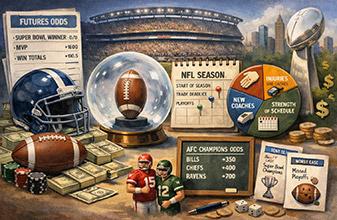Sports Betting Problems and Solutions, Part Two

Sharp Sports Betting is a tool for those interested in winning money at sports betting. The book explains the most common sports bets, what all the numbers mean, and the mathematics behind the numbers.
Let’s discuss some principles of sports betting. All sports bettors should learn the information below. All other kinds of casino advantage players, including blackjack players of all skill sets, which includes card counters, should also have a good working knowledge of Expected Value.
Problems 6-10, continued from the previous article in this series
Problem 6
Suppose I can receive +185 on something that I think will happen around forty percent of the time. What would my win rate be?
A bet of $100 will win $185 about 40 percent of the time, and will lose about 60 percent of the time. Thus the average $100 turns into $114, which is 40 percent of $285. If your forty percent is accurate, your win rate is fourteen percent.
Problem 7
A sportsbook, whether it be in Las Vegas or online or elsewhere, offers -400 on something that I think will win 75 percent of the time. Is that a good bet?
No, it is not a good bet. You need to win 80.0 percent of the time to break even on bets you make at -400. You need to have more than 80.0 percent chance of winning to have an edge. Your estimate of winning 75 percent of the time means the book has an edge over you on that bet.
Problem 8
A sportsbook offers a prop with -115 on one side and -115 on the other side. How does this compare with the normal -110 with regards to the book’s expected win, in percent?
At -110 you need 52.4 percent predictive accuracy to break even. At -115, you need 53.5 percent predictive accuracy to break even.
At -110 on both teams, a sportsbook with balanced action earns $10 per $220 of action, or 4.5 percent.
At -115 for both teams, a sportsbook with balanced action earns $15 per $230 of action, or 6.5 percent. You can derive that yourself by assuming $115 bet on each team. Whichever bet wins will receive $215, and the sportsbook will keep the other $15.
Problem 9
I like the Braves -280 vs. Cardinals. I think the break-even point is a line of -350. What is my edge if I am right about the -350?
The win rate associated with -350 is 77.8 percent. If your -350 is correct, your $280 bet has a 77.8 percent chance of turning into $380. Multiplying .778 times $380 yields $295.64. Since you have only three-digit accuracy on the .778, you should round off the $295.64 to three digits, getting $296.
If your -350 is right, the average $280 you invest in the Braves will turn into $296. Dividing 296 by 280 yields 105.7 percent. You have about a 5.7 percent edge on this bet.
Problem 10
If I think the break-even point is a line of -350 on the Braves and I want to invest my money only on bets on which I think my edge is at least 10 percent, what is the worst line I should take?
The win rate associated with a line of -350 is 77.8 percent winners. That 77.8 percent must cover both your wager and the 10 percent of your wager that you expect to gain. Thus that 77.8 percent must cover 110 percent of your wager. Dividing 77.8 percent by 1.10 (which is 110 percent) yields 70.7 percent. That’s the break-even win rate you need in order to have an expected result of getting your money back plus 10 percent.
For a break-even win rate of 70.7 percent, you need bet terms between -239 and -245.
If you think the line should be -350 and you want to earn 10 percent return on investment, you should hold out for a line of -241 or better.
This is part of an occasional series of articles.
Excerpted with permission from Sharp Sports Betting by Stanford Wong, edited for this format.
For more about online sports betting, please visit www.latestsportsbonuses.com











Please log in or register to leave a comment